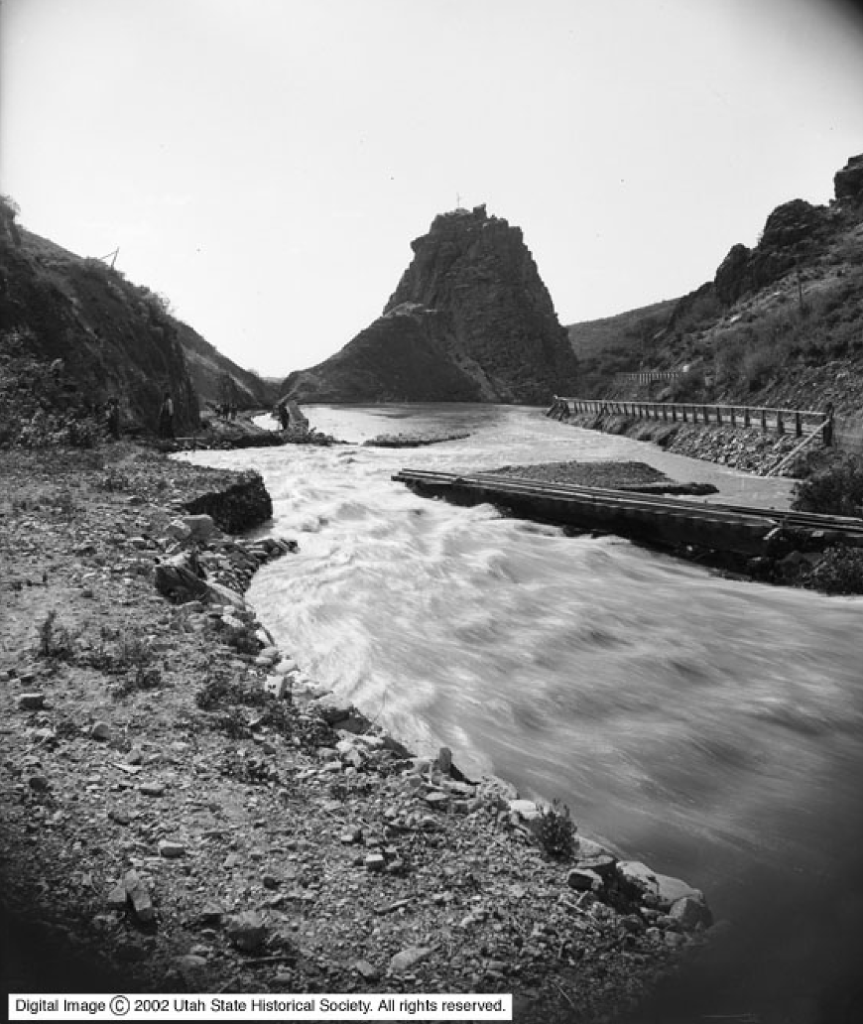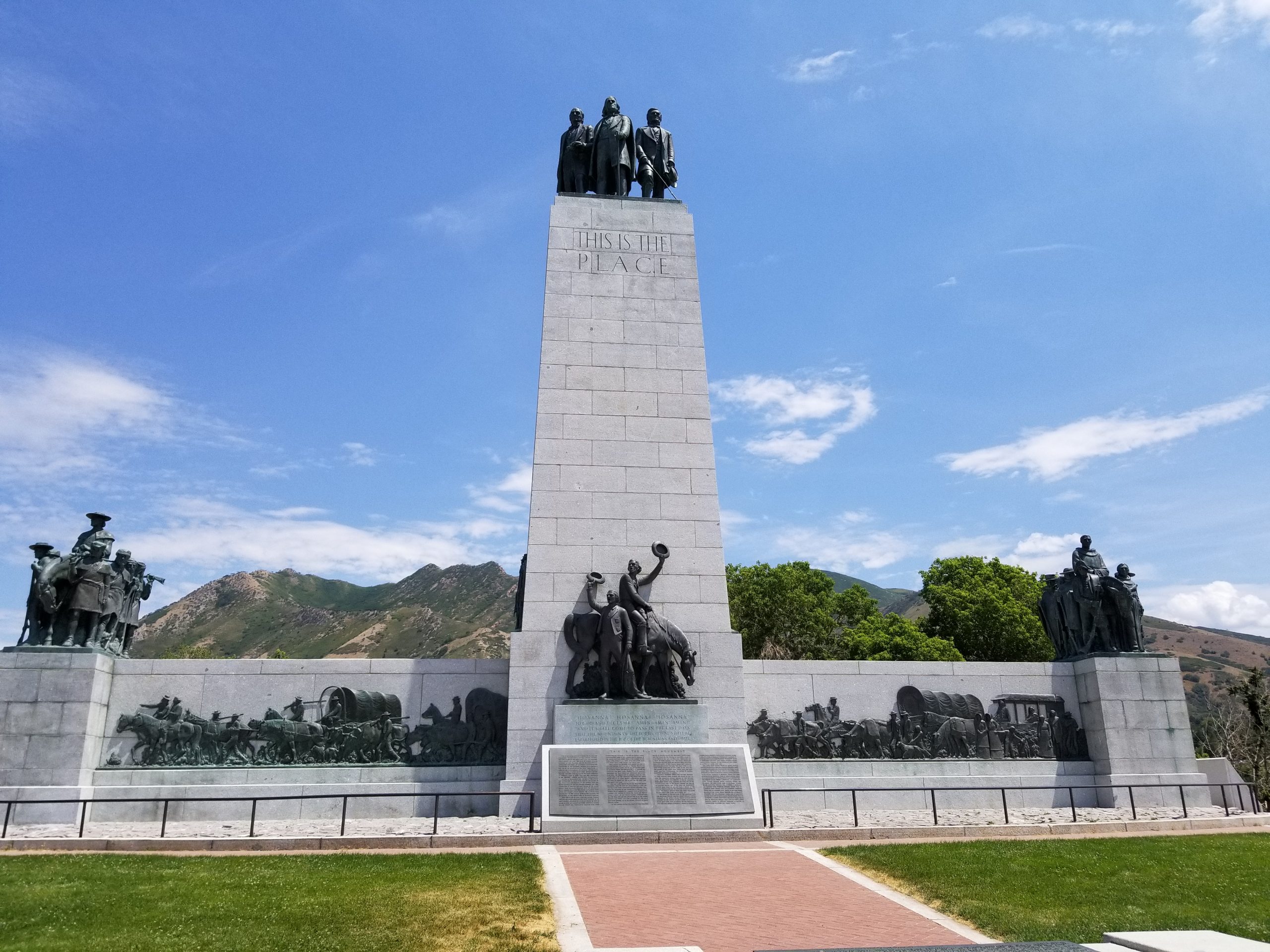Suicide Rock and Reservoir Historical Marker
Write up by Samuel Scott
Placed by: Sons of Utah Pioneers Holladay Chapter, No. 79, dedicated 1996

Location of the Historical Marker near Suicide Rock

Latitude 40°42’34.67″N
Longitude 111°47’49.57″W
Historical Marker Text:

SUICIDE ROCK & THE RESERVOIR
“One of the foremost sights that met the eye of the early travelers when they reached the mouth of Parley’s Canyon before entering into the valley of the Great Salt Lake, was a huge mass of red rock which stood in the middle of the mouth of the canyon. It consisted mainly of red sandstone and had stood as a sentinel for centuries.
For hundreds of years, it stood as a watchtower for the Indians until, as the story goes, an Indian maiden upon learning of the death of her brave, leaped from the top, to her death on the rocks below, giving it the name of Suicide Rock. Now, it is a billboard for the youth who dare to climb its heights with a paint brush or spray can.
In the settlement of the valley with a constant increase in population, the water from the various canyon streams of the Wasatch Range provided irrigation as well as culinary water for the people. In order to free up more of the canyon water for culinary use, a canal was built from Jordan Narrows conveying Jordan River water to the east bench of the Salt Lake valley. The Jordan and Salt Lake City Canal was begun in 1879, and completed in 1882, and has remained in constant use since. The canyon streams were thereafter enhanced with reservoirs to catch and retain the spring runoff, for use in the drier seasons.
In about 1891 a reservoir was built on the east side of Suicide Rock to help contain the spring run-off from washing out the farms west of the canyon mouth, as well as to help provide a way of getting water from the stream to where it was needed. From this reservoir, and ditches from the canyon stream above the reservoir, culinary along with irrigation water was conveyed to the various farms below as well as up to the plateaus on the north and south sides of the hollow which were located above the canal. This reservoir served for many years until an extremely wet spring one year washed out part of the reservoir and some of the railroad tracks and roadway in the canyon. Culinary water supplies had been further enhanced by this time and a direct connection was made to use Parley’s Canyon water, so the reservoir was never replaced.
Of the stream, the roadway, and the railroad line that ran in the narrow spaces between the rock and canyon sidewalls, only the stream remains.”
Site No. 79 Holladay Chapter, Sons of Utah Pioneers Dedicated 1996

Suicide Rock on February 9, 2022.
Extended Research:
Suicide Rock is located at the mouth of Parleys Canyon, a canyon named after the Mormon pioneer Parley P. Pratt who had scouted the canyon in 1848.[1] The sandstone rock formation that is known today as Suicide Rock was also known as Sentinel Rock, because it is thought that it was used as a lookout point for American Indians long before the arrival of Mormon settlers. The name Suicide Rock became more popular after a story circulated about an American Indian maiden who threw herself off of the rock out of the grief of losing her brave lover. A similar story is told about “Squaw Peak” in Utah county of “one squaw killing herself falling from a precipice” following a military skirmish, and Suicide Rock in Idyllwild, California bears a legend of an American Indian princess and her lover committing suicide rather than being separated. The popularity of this trope over a wide variety of areas makes it unlikely to be factual, and it possibly emerged as a response to Helen Hunt Jackson’s novel Ramona, published in 1884, which popularized the tale. Various locations across the country picked up on the theme and used it in order to promote tourism.[2]
In 1892 Salt Lake City officials built a reservoir adjacent to the rock in order to supply culinary water from Parleys Creek to the valley. It was Utah’s first municipal culinary water storage reservoir.[3] The construction of the reservoir would have negative consequences for a community named Mountain Dell. The water provided by the reservoir during this time was unfiltered, which meant that contamination could easily lead to widespread illness. Since the community of Mountain Dell lived upstream from the reservoir they suddenly posed a threat of contaminating Salt Lake City’s drinking water with their animals and waste. This was confirmed in 1903 when a typhoid outbreak afflicted hundreds in Salt Lake City. The source of the epidemic was traced back to water from Parleys Creek, and a local farm situated upstream.[4] According to historian Cullen Battle, “In Mountain Dell, the city began buying up properties with animal lots and outhouses next to the creeks. The small landowners were the first to go, and the village quickly de-populated. Soon, the post office closed, and the school district and ward dissolved. By about 1907, most residents had given up their homes and farms, and Mountain Dell became—and remains today—an area devoted to watershed protection.” Nevertheless, the process of buying out and removing landowners on Mountain Dell lasted until 1920, and a case involving Seymour B. Young went as far as the Utah Supreme Court in 1915, ultimately ruling in favor of Salt Lake City officials.[5]
The reservoir eventually fell out of use after it experienced flooding, and advancements in technology along with the construction of Little Dell Reservoir led to its demise. Since then, Suicide Rock has become a popular recreation spot for young adults. Many of Utah’s high school and collegiate students continue the tradition of spray-painting, or “tagging,” the rock each year, rendering it into an ever-changing illustration of the times. In addition to this, one might also discover the not-so-well kept secret pastime of “shooting the tube” within walking distance of Suicide Rock. A rite of passage for some, anyone looking to cool off can temporarily dam up the entrance of a tunnel carrying Parley’s Creek water under the freeway. When the makeshift dam is pulled, the sudden rush of water propels thrill seekers through on a ride to the other side! A link to a video of the activity is included below. [6]

Utahns preparing to “shoot the tube.”[7]

“Waterworks at mouth of Parleys Canyon, circa 1900. Salt Lake City built this reservoir seven miles downstream of Mountain Dell in the early 1890s to supply drinking water to city residents. C. R. Savage Photo.” [8]

“Image shows Suicide Rock at the base of what was once Parley’s Canyon Reservoir.” [9]

“Water flows over a remnant of the wall of the old Parley’s Canyon reservoir.” [10]

Aerial view of Parley’s Canyon Reservoir[11]

“Parley’s Creek – Suicide Rock, Flood Damage” Ca. 1910 [12]

Spray paint decorates the entirety of Suicide Rock
Photo by Joe Penacoli[13]
For Further Reference
Secondary Sources
Battle, Cullen, “Ghosts of Mountain Dell: Transportation and Technological Change in the Wasatch Mountains,” Utah Historical Quarterly 86, No. 1 (2018).
Farmer, Jared. On Zion’s Mount : Mormons, Indians, and the American Landscape. Cambridge: Harvard University Press, 2008.
“First Ascent of the Nose, Suicide Rock,” semi-rad.com, (accessed April 8, 2022).
Pugh, Jeremy. “A Unique Utah Summer Tradition: ‘Shooting the Tube,’” Salt Lake Magazine, July 27, 2018.
“Summit Signature: 27J Suicide Rock,” Hundred Peaks Section, Angeles Chapter of the Sierra Club, accessed 03/29/2020.
Primary Sources
“Parley’s Creek – Suicide Rock, Flood Damage,” University of Utah, J Willard Marriot Digital Library. Last modified May 6, 2021.
Korn, J. Roderic, “The Golden Pass Road,” Utah Historical Quarterly, vol. 19 (1951).
“Parley’s Canyon Reservoir P.13,” University of Utah, J. Willard Marriot Digital Library, Last modified May 6, 2021.
[1] J. Roderic Korn, “The Golden Pass Road,” Utah Historical Quarterly, vol. 19 (1951), 229-236.
[2] “Summit Signature: 27J Suicide Rock,” Hundred Peaks Section, Angeles Chapter of the Sierra Club, accessed 03/29/2020.
Jared Farmer, On Zion’s Mount : Mormons, Indians, and the American Landscape, (Harvard University Press, 2008), 274-275.
[3] Cullen Battle, “Ghosts of Mountain Dell: Transportation and Technological Change in the Wasatch Mountains,” Utah Historical Quarterly, volume 86, no. 1 (2018).
[4] Cullen Battle, “Ghosts of Mountain Dell: Transportation and Technological Change in the Wasatch Mountains,” Utah Historical Quarterly, volume 86, no. 1 (2018)
[5] Cullen Battle, “Ghosts of Mountain Dell: Transportation and Technological Change in the Wasatch Mountains,” Utah Historical Quarterly, volume 86, no. 1 (2018)
[6] Jeremy Pugh, “A Unique Utah Summer Tradition: ‘Shooting the Tube,’” Salt Lake Magazine, July 27, 2018.
[7] Jeremy Pugh, “A Unique Utah Summer Tradition: ‘Shooting the Tube,’” Salt Lake Magazine, July 27, 2018.
[8] Cullen Battle, “Ghosts of Mountain Dell: Transportation and Technological Change in the Wasatch Mountains,” Utah Historical Quarterly, volume 86, no. 1 (2018).
[9] “Reservoir at Parley’s Canyon, Inspecting Conduit,” J. Willard Marriot Digital Library, The University of Utah, Last modified May 6, 2021.
[10] “Parley’s Reservoir,” J. Willard Marriot Digital Library, The University of Utah, Last modified May 6, 2021.
[11] “Parley’s Canyon Reservoir P.13,” J. Willard Marriot Digital Library, University of Utah, Last modified May 6, 2021.
[12] “Parley’s Creek – Suicide Rock, Flood Damage,” J. Willard Marriot Digital Library, University of Utah, Last modified May 6, 2021.
[13] “First Ascent of the Nose, Suicide Rock,” semi-rad.com, (accessed April 8, 2022).
